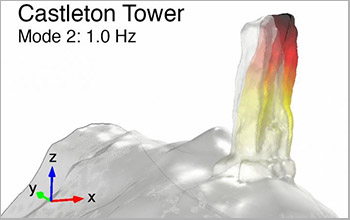This 400 foot sandstone spire pulses at a rate within the range a human heartbeat. A team of geologists and rock climbers worked together to gather measurements of the rock’s vibrations and movements, with the particular aim to “evaluate the response of rock towers to external vibrational inputs” (Moore et al. 2019) such as wind, waves, and far-off earthquakes. The vibrations of the stone are well below the range of human hearing, and they have been scaled up in this sound file (click below) for audibility – though it still may not come through on laptop speakers. The deep rumbling drone swells and pulses with an organic consistency, and with the right set of speakers the sound is felt more than it is heard. This intersection of scientific study and sound art brings natural phenomena into our perceptive range, albeit through intensive mediation, and prompts us to consider the sensitivity and responsiveness of both the biotic and the abiotic forms around us.
The graphic below, sourced from the National Science Foundation page and credited to the Jeff Moore Lab at the University of Utah, gives an exaggerated display of the movement of Castleton Tower. The primary resonant frequencies of the tower were measured at 0.8 and 1 Hz. To gather this data, simultaneous seismometer readings were taken from the top of the stone formation and from a distance 300 feet from the base of the formation. (source)




